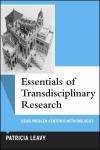 Patricia Leavy. Essentials of Transdisciplinary Research: Using Problem-Centered Methodologies. Walnut Creek, CA: Left Coast Press, 2011.
Patricia Leavy. Essentials of Transdisciplinary Research: Using Problem-Centered Methodologies. Walnut Creek, CA: Left Coast Press, 2011.
There has been a fair amount written about transdisciplinarity in the pages of Integral Leadership Review, but none of it as practical for scholars, innovators and researchers as this guide to the methodologies. Keep in mind that transdisciplinary is about bridging, not just among the academic disciplines, but with the community as well. It is about addressing complex, evolving, messy problems. It is the most integral of problem-centered methodologies. Yet, for this work, Leavy focuses her attention on the academy:
Transdisciplinarity is an approach to conducting social research that involves synergistic collaboration between two or more disciplines with high levels of integration between the disciplinary sets of knowledge. Transdisciplinary research practices are issue- or problem-centered and prioritize the problem at the center of research over discipline-specific concerns, theories or methods. (9)
She goes on to say that this research is responsive to public needs. I consider this a rather narrow interpretation of the scope or level of involvement of individuals and institutions outside of academia. TD with its problem-centered approach involves devising and developing ways for the stakeholders in the problem to be a part of the research, not as subjects, but as participants. Perhaps I should have said “not only” as subjects, because many transdisciplinary projects focusing on economic development or on ecology and sustainability will also include seeking data from communities about their views, understanding, preferences and aspirations. Nevertheless, as we show in our book, Transversity (McGregor and Volckmann 2011) one of the greatest challenges to undertaking any transdisciplinary approach is the boundaries of disciplines within the academy. It is appropriate to address the methods and challenges faced by researchers within the academy as a step toward realizing capabilities for stakeholder involvement and integration into the research and analysis of messy problems.
One of Leavy’s purposes in offering this book is to [point out that “there is a social justice or moral underpinning to transdisciplinary research.” She notes,
“In essence, transdisicplinary presupposes that contemporary social/human issues and problems can only be understood and solved if viewed holistically and not artificially broken down into narrow research purposes.”
In her discussion she points out the problems with definitions:
First, definitions always represent a form of closure… researchers should be free to label them work as they see fit…
Second, the literature explicitly on transdisciplinarity has emerged disproportionately in a few fields and on a few topics (medicine, environmental studies/sustainability), and therefore there are inherent biases…
Third, the literature on transdisciplinarity is relatively new and thus, as an emerging field, there is a flurry of ongoing debate and negotiation taking place.
Thus, this is a time for engaging in the evolution of our understanding and practices. Thereby, she offers several principles of transdisciplinarity.
- Issue- or problem-centered
- Holistic or synergistic research approach
- Transcendence (transcending disciplinary perspectives)
- Emergence (of new conceptual and methodological frameworks)
- Innovation
- Flexibility (openness to new ideas and new insights)
Whether approaching transadisciplinarity from within academia or from communities of interest, business and industry and other stakeholder positions, here is a guide that should prove helpful in thinking not only how to go about addressing evolving issues, but opportunities for innovation in all aspects of life and practice.
